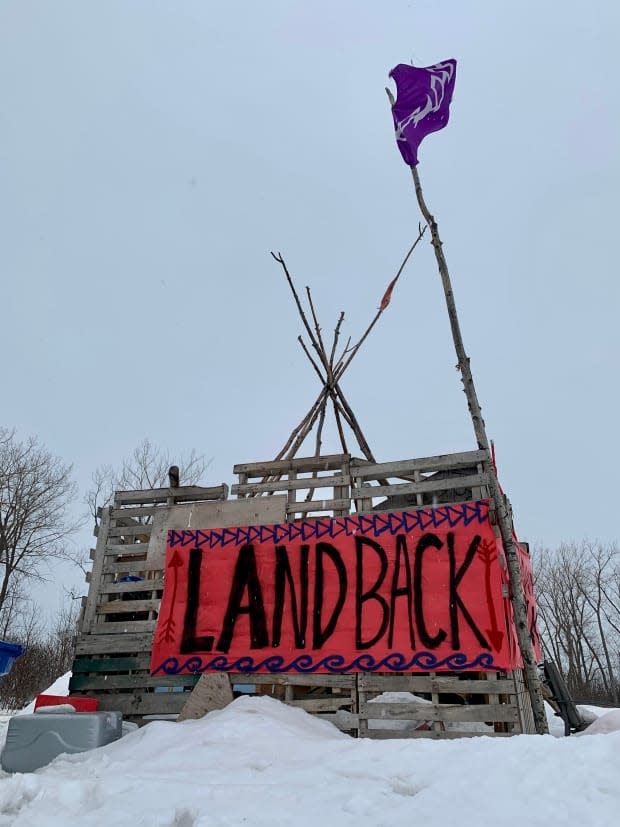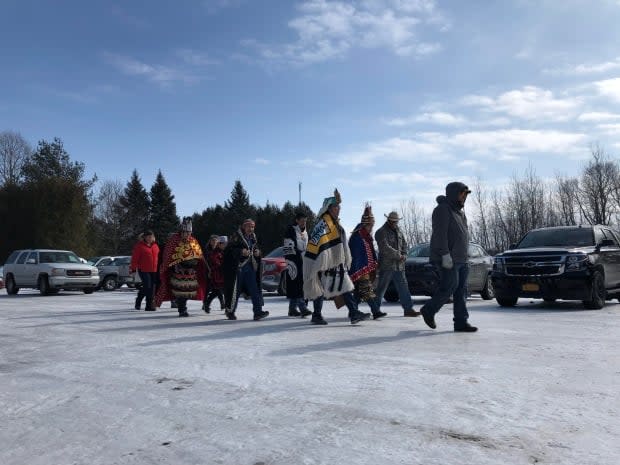A year after rail blockades, the people's fire in Kahnawake still burns

For Onowakohton Rusty Nolan, the people's fire in Kahnawake, Que., has become a second home.
It's where he feels a sense of comfort, comradery and unity and is able to show solidarity to First Nations across the country facing injustices.
"It's a symbol of our resistance," said Nolan.
"It's a symbol of who we are, our strength, and lately it's been a place to give us a little bit of hope."
The fire, which is located in a green space at the foot of the Honoré Mercier Bridge, was lit on Feb. 8, 2020 when community members blockaded Canadian Pacific Railway lines in solidarity with Wet'suwet'en hereditary chiefs' ongoing opposition to the Coastal GasLink project in northern B.C.
Even though the barricades have since come down, the fire still burns a year later.

Nolan, who is one of the firekeepers, said being there evokes a sense of pride.
"It's like we're on standby for Wet'suwet'en. We didn't want to give up. We didn't want to go home," he said.
"I feel like I'm letting people know that I'm there and they can sleep tight at night. It's a nice big warm fire that is spreading positive vibes far."

Ongoing fight
Roxann Whitebean, a filmmaker in Kahnawake, was asked to read a letter last year to a crowd of reporters on behalf of the people of the fire, explaining the decision to take down the blockade.
She said the fact that the camp is still up and the fire is still going sends a powerful message.
"It's still a solidarity fire burning for the Wet'suwet'en, and I'm happy that people are still going and that there's a level of visibility there," said Whitebean.
"Their fight is ongoing so we have to remind people that they are still dealing with this."

The hereditary chiefs still oppose the pipeline, and the support has not gone unnoticed.
"It's a continued fight and I really appreciate the fire is still on with the alliance we're building with Kahnawake," Wet'suwet'en hereditary Chief Woos said.
"We stood up to create awareness, and that awareness has been a highlight of what is actually out there which is racism. The message that I get to Indigenous people is to continue to stand up against this racism."
A place for solidarity
In addition to showing solidarity with Wet'suwet'en hereditary chiefs throughout 2020, the people's fire also helped raise awareness locally of the Black Lives Matter movement, 1492 Land Back Lane, and the plight of Mi'kmaw lobster fishers.
The show of solidarity is something Whitebean said the people's fire has been doing for well over a decade and will continue to do.
"Even when the physical structure comes down, the people still carry that same love within their hearts to want to make social change and to try to better our nation and and amplify the voices of people who are dealing with injustice within their communities," she said.
As for Nolan, he said he just wants people who pass by the camp to know that it's a place of solidarity, unity and peace rather than harmful stereotypes often portrayed in media when Indigenous people use blockades to raise awareness of injustices.
"We're Mohawks. We're still here. We're not going anywhere, and we're here for peace," said Nolan.
"The fire is still there because our issues are neverending. Every time our fire is lit, it lasts longer and longer. It just seems like our resistance is becoming brighter and brighter."

